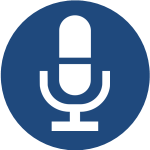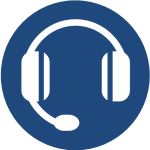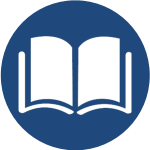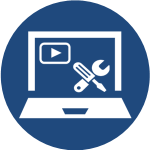19 Creating and Editing Audio Resources
 Like video, audio can be a great tool for creating and sharing learning resources with your students. It can also be a great tool for students to use to present their growing knowledge and skills. In one of my undergraduate Education courses, I work with participants to learn how to use digital tools to create, edit and share their own audio resources.
Like video, audio can be a great tool for creating and sharing learning resources with your students. It can also be a great tool for students to use to present their growing knowledge and skills. In one of my undergraduate Education courses, I work with participants to learn how to use digital tools to create, edit and share their own audio resources.
This chapter looks at the process of creating a simple podcast and how you could implement podcasting as a learning activity in your courses. Participants in my undergraduate course create their own podcasts and upload them within our learning management system. This type of distribution will be possible in your classrooms using Canvas, Moodle, or any other LMS. This chapter also looks at how you can distribute your audio resources as podcasts to wider audiences using online platforms.
What Are Podcasts?
Originally the term “podcast” was delimited to audio-only programs. Podcasts that included video were called “vodcasts.” As mobile devices have moved from audio only (like the original iPod) to include video (like iPhones and Android phones), the term “podcast” has become a generic term for both podcasts and vodcasts.
A podcast is an audio/video file distributed over the internet through an RSS feed (Really Simple Syndication). You can create your RSS feed by editing an XML file to point at your audio/video file(s) and uploading everything to a web server. This will allow individuals to subscribe to your podcast through a podcatcher service like iTunes (Apple, 2023). Your XML file can be updated every time you publish a new episode so subscribers can download the media file. This process sounds complicated (and it can be), but the software is available to simplify the process.
Jackson (2015) provides a good overview of what podcasts are:
Why Podcast in Class?
Watch Lenihan (2016) for a brief discussion of the benefits of podcasting in education.
There are essentially three kinds of podcasts:
- audio-only podcasts,
- “enhanced” podcasts that included graphics, and
- “Video” podcasts or vodcasts that include video (either of the “talking head” variety or with both motion and slides on the video screen (think of the kind of thing that we saw Wesch do on YouTube).
Student Attitudes and Podcasts
 Many articles on the web discuss student attitudes toward podcasts or vodcasts. Ogawa and Nickles (2006) and Palmer and Devitt (2007) provide some information about where this technology originated for education. Ogawa and Nickles (2006) provided both a podcast and a file with related graphics. One of the audience members at a session presented by Ogawa and Nickles at the World Conference on E-Learning in Corporate, Government, Healthcare, and Higher Education in 2006 asked why they provided a graphics file if the intention was that the students would listen to the lecture on their iPod (supplied with the course). The answer was that they had queried students as to whether they wanted audio with graphics or just audio. Most of the students chose audio-only. However, in the evaluation, there was a request for graphics. On the other hand, Palmer and Devitt (2007) looked at vodcasts and indicated that students wanted pictures and words.
Many articles on the web discuss student attitudes toward podcasts or vodcasts. Ogawa and Nickles (2006) and Palmer and Devitt (2007) provide some information about where this technology originated for education. Ogawa and Nickles (2006) provided both a podcast and a file with related graphics. One of the audience members at a session presented by Ogawa and Nickles at the World Conference on E-Learning in Corporate, Government, Healthcare, and Higher Education in 2006 asked why they provided a graphics file if the intention was that the students would listen to the lecture on their iPod (supplied with the course). The answer was that they had queried students as to whether they wanted audio with graphics or just audio. Most of the students chose audio-only. However, in the evaluation, there was a request for graphics. On the other hand, Palmer and Devitt (2007) looked at vodcasts and indicated that students wanted pictures and words.
Creating Podcasts in the Classroom
It’s a bit longer… but Listenwise (2018) has shared an excellent webinar on Creating Podcasts in Class:
Using Audacity to Create and Edit Audio Resources
One of my favorite tools for creating and editing audio resources is Audacity (n.d.), which is an open-access application. The following tutorial video by Flynn (2018) will help to get you started using Audacity to create a podcast:
Using SoundCloud to Share a Podcast
One of my favorite tools for sharing and streaming audio resources is SoundCloud (n.d.). Han (2018) provides a tutorial on how to use SoundCloud to share your audio recordings or podcasts:
Richard Byrne (2015) demonstrates how to use SoundCloud to share your audio files privately with your students:
A Sample “Podcast”
Here is an example of a short sample podcast (Power, 2022) that I created as an in-class demonstration for a group of undergraduate educational technology students during the Fall 2022 term.
Further Reading
 The following are some good resources if you are interested in taking a deeper look at the use of audio recordings such as podcasts in your instructional design projects:
The following are some good resources if you are interested in taking a deeper look at the use of audio recordings such as podcasts in your instructional design projects:
- Bradbury (2016)’s. Podcasts Expand Classroom Walls.
- Shankar-Brown and Brown (2014)’s. Today’s Vodcast: Sunny and Clear, with an Increased Chance of Learning.
- Vasquez (2015)’s. Podcasting as Transformative Work.
Activity: Creating a Podcast
The ChallengeCreate a short podcast that discusses the benefits and/or drawbacks of podcasting in education, and how you could use podcasting to either create learning resources, or as a student-generated learning activity, in your own teaching and learning context. Share your podcast using the Week 8 Discussions forum here in Moodle. You will:
You may choose to:
Required ToolsClick on links to download software.
Optional Tools
Additional Resources: Free Music for PodcastsLooking for some royalty-free music to use for your podcasts? Try these resources:
|
References
Apple (n.d.). Apple Music. https://music.apple.com/us/browse
Apple (2023). iTunes. https://www.apple.com/ca/itunes/
Audacity (n.d.). https://www.audacityteam.org/download/
Bradbury, J. (2016). Podcasts Expand Classroom Walls. Education Digest, 81(8), 46-48.
Byrne, R. (2015, May 4). How to Privately Share Audio Recordings on SoundCloud. https://youtu.be/vzenNHTBLMI
Discover Pods (2019, February 17). The 5 Best Free Podcast Hosting Services. https://discoverpods.com/best-free-podcast-hosting/
Flynn, P. (2018, February 17). How to Record and Edit a Podcast in Audacity (Complete Tutorial). https://youtu.be/xl-WDjWrTtk
Google (n.d., a). Google Podcasts. https://podcasts.google.com/
Google (n.d., b). Google Sites. https://workspace.google.com/intl/en_ca/products/sites/
Han, S. (2018, March 15). How to Publish a Podcast Episode on Soundcloud | Walkthrough. https://youtu.be/z9WE7iTPqGs
Jackson, D. (2015, August 24). What is Podcasting? https://youtu.be/oRvSj7UWuvU
Kwantlen Polytechnic University (2022). Find Open Audio/Music. [LibGuide]. https://libguides.kpu.ca/open/open-audio-music
Lenihan, E. (2016, February 26). John Linney – Podcasting for Education: In the Classroom. https://youtu.be/sommEBL6DW0
Listenwise (2018, June 12). Creating Podcasts in Class – 2017 Webinar. https://youtu.be/uIVtMGkoG5o
Ogawa, M., & Nickles, D. (2006). Improving students perceptions in large-enrollment courses through podcasting. Proceedings of E-Learn: World Conference on E-Learning in Corporate, Government, Healthcare, and Higher Education, Honolulu, Hawaii, October 2006. https://www.editlib.org/p/23693
Palmer, E. J., & Devitt, P. G. (2007). A method for creating interactive content for the iPod, and its potential use as a learning tool: Technical advances. BMC Medical Education. https://bmcmededuc.biomedcentral.com/articles/10.1186/1472-6920-7-32
Power, R. (2022, October 3). Rob’s F22 Podcast Demo. SoundCloud. https://on.soundcloud.com/4bu9J
Shankar-Brown, R. r., & Brown, B. b. (2014). Today’s Vodcast: Sunny and Clear, with an Increased Chance of Learning. Middle School Journal, 45(3), 19-25. https://www.tandfonline.com/doi/abs/10.1080/00940771.2014.11461888
SoundCloud (n.d.). Stream and listen to music online for free with SoundCloud. https://soundcloud.com/
Spotify (2023). What is Spotify? https://support.spotify.com/us/article/what-is-spotify/
Tolley, C. (2005). RSS Buddy. http://www.tolley.info/rssbuddy/download.html
Vasquez, V. M. (2015). Podcasting as Transformative Work. Theory Into Practice, 54(2), 147-153. https://www.tandfonline.com/doi/abs/10.1080/00405841.2015.1010848
YouTube (n.d.). YouTube Music Library. https://www.youtube.com/audiolibrary

 This activity will introduce you to several software tools you can use to develop podcasts and publish your work.
This activity will introduce you to several software tools you can use to develop podcasts and publish your work.